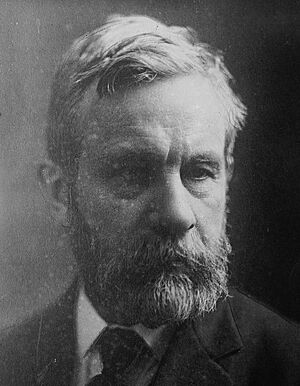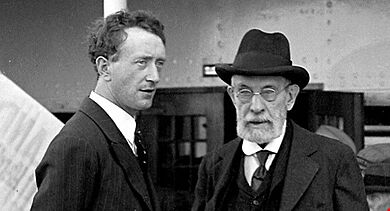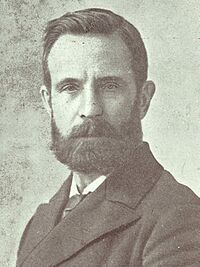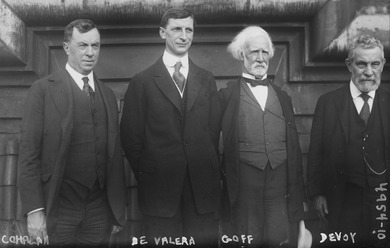John Devoy facts for kids
Quick facts for kids
John Devoy
Seán Ó Dubhuí |
|
|---|---|

Devoy in 1916
|
|
| Born | 2 September 1842 Kill, County Kildare, Ireland
|
| Died | 29 September 1928 (aged 86) |
| Resting place | Glasnevin Cemetery, Dublin, Ireland |
| Organization | Irish Republican Brotherhood Clan na Gael |
| Movement | Irish Republicanism |
John Devoy (Irish: Seán Ó Dubhuí) was an Irish republican and journalist. He owned and edited The Gaelic American, a weekly newspaper in New York, from 1903 to 1928.
Devoy spent over 60 years working for Irish independence. He was one of the few people involved in the Fenian Rising of 1867, the Easter Rising of 1916, and the Irish War of Independence (1919–1921).
Contents
Early Life and Beginnings
John Devoy was born in Kill, County Kildare, Ireland, on September 3, 1842. His father was a farmer. After the terrible Irish famine (1845-1852), his family moved to Dublin.
In Dublin, Devoy's mother found work at a brewery. John went to night school at the Catholic University. He then joined a group called the Fenians. In 1861, he traveled to France and joined the French Foreign Legion. He served in Algeria for a year before returning to Ireland. Back home, he became a Fenian organizer in Naas, County Kildare.
Leading the Nationalist Movement
In 1865, many Fenians were arrested. James Stephens, who started the Irish Republican Brotherhood (IRB), gave Devoy an important job. Devoy became the Chief Organizer of Fenians within the British Army in Ireland. His task was to convince Irish soldiers in the British Army to join the IRB.
In November 1865, Devoy helped Stephens escape from Richmond Prison in Dublin. This was a very daring plan!
In February 1866, the IRB leaders wanted to start an uprising right away. Devoy agreed, as he believed there were 80,000 Fenians in the British Army. However, Stephens disagreed. The British government found out about the plan from informers. They quickly moved Irish regiments out of the country and brought in British soldiers. Devoy was arrested in February 1866 and sent to Mountjoy Gaol. He was later sentenced to fifteen years of hard labor for a serious crime against the government. While in Portland Prison, Devoy organized prison strikes. He was then moved to Millbank Prison in Pimlico, London.
Life in America
In January 1871, John Devoy was released from prison. He was sent to the United States as one of the "Cuba Five" – a group of Irish prisoners exiled there. The U.S. House of Representatives even welcomed him. Devoy became a journalist for the New York Herald newspaper.
He also became very active in Clan na Gael, an important Irish republican group in the United States. Under Devoy's leadership, Clan na Gael became the main Irish republican organization in America. In 1877, he made sure the group worked closely with the Irish Republican Brotherhood back in Ireland.
In 1875, Devoy and John Boyle O'Reilly helped six Fenians escape from Fremantle Prison in Western Australia. They used a ship called the Catalpa for this amazing rescue. In 1879, Devoy visited Ireland to check on Fenian groups. He met Michael Davitt and Charles Stewart Parnell in Paris. He convinced them to work together on a plan called the "New Departure" during the growing Land War in Ireland.
Supporting Irish Independence from Abroad
John Devoy worked hard to raise money and encourage Irish-Americans to support Irish independence. During World War I, he tried to help the Easter Rising in 1916. In 1914, Patrick Pearse, an Irish leader, visited Devoy in America. Later that year, Roger Casement worked with Devoy to raise money for guns for the Irish Volunteers. Pearse was very impressed by Devoy's long dedication to Irish freedom. He called Devoy "the greatest Fenian of them all."
When Britain and Germany went to war in August 1914, Casement and Devoy arranged a meeting. They met with a top German diplomat in New York and members of Clan na Gael. The Clan members suggested a plan: if Germany sold guns to the Irish rebels and sent military leaders, the rebels would fight against Britain. This would distract Britain from its war with Germany. The German diplomat listened and promised to tell Berlin.
Devoy decided to contact Berlin directly. Since Britain controlled the seas and had cut the transatlantic cable, they had to send a messenger. John Kenny, president of the New York Clan na Gael, was chosen. Kenny met with German officials and then traveled to Dublin. He told Tom Clarke and other IRB members about the plan. He brought back a list of what the IRB needed: guns, money, and military leaders.
Devoy also helped fund Roger Casement's trip to Germany. Casement went there to get German help for Ireland's fight for freedom. This included forming Casement's Irish Brigade. Devoy was worried about Casement's companion and advised Casement to return to the U.S., but Casement did not listen.
In 1915, Joseph Plunkett visited Devoy in the United States and Casement in Germany. Plunkett told Devoy that the German military was cooperating. He said an uprising would happen soon. The idea was that Ireland would become independent if Germany helped the upcoming Easter Rising. Germany was supposed to send guns and experts, and attack Britain at the same time as the Rising.
The guns were sent on a ship called the SS Libau. However, there was a misunderstanding about when the guns should arrive. The IRB men sent to meet the ship drove off a pier in the dark and drowned. The ship's captain sank the ship, and the guns went to the bottom of the sea. Casement was also captured because of this timing issue.
In 1916, Devoy helped create the Friends of Irish Freedom. This was a large group that supported Irish independence, with 275,000 members at one point. They supported Woodrow Wilson for president in 1916 because he wanted America to stay neutral in the war. After America joined the war in April 1917, the Friends became less public.
After the war, Devoy played a key role in the Friends' efforts to get self-rule for Ireland. This was in line with Wilson's "Fourteen Points" plan. However, Wilson did not promise to recognize the newly declared Irish Republic. This led to disagreements between American-Irish republicans and the Friends.
Devoy and Daniel F. Cohalan of the Friends had a big disagreement with Éamon de Valera. De Valera was the de facto Irish president. He visited the United States in 1919 and 1920 to get U.S. recognition for the Irish Republic and raise money. Devoy was very critical of De Valera's visit.
De Valera wanted Americans to follow Irish policy. So, he formed the American Association for the Recognition of the Irish Republic in 1920. Devoy did not trust de Valera, but he greatly admired Michael Collins. Devoy called Collins "Ireland's Fighting Chief." Even without official recognition, $5.5 million was raised to help the new Irish nation.
Personal Life
John Devoy never married and did not have children. Around 1866, he was engaged to Eliza Kenny, a local farmer's daughter. However, Devoy's arrest and imprisonment meant the marriage could not happen. Eliza waited for Devoy, but she eventually married Thomas Kilmurry in 1884.
When Devoy returned to Ireland in 1924, Eliza, who was then an elderly widow, contacted Devoy's relatives. Devoy had thought Eliza had died, but it was actually her sister. After 58 years, Devoy visited Eliza, who was living with her niece in Naas. They continued to write to each other until her death in 1927.
Later Years and Legacy


John Devoy was the editor of The Gaelic American from 1903 until he passed away.
He supported the Anglo-Irish Treaty of 1921. This treaty led to the creation of the Irish Free State during the Irish Civil War. In 1924, Devoy made a triumphant return to Ireland. He was an honored guest of the Cumann na nGaedheal Government, led by W. T. Cosgrave.
Devoy died peacefully on September 29, 1928, at the age of 86, while visiting Atlantic City, New Jersey. His death caused widespread sadness. His body was brought back to Ireland, where a state funeral was held. He was buried in Glasnevin Cemetery in June 1929.
Devoy Barracks in Naas, County Kildare, was named after him. It housed the Irish Army Apprentice School from 1956 to 1998. A large memorial to him stands on the road between his hometown of Kill and Johnstown. On October 25, 2016, a statue of Devoy was unveiled in Poplar Square, Naas, County Kildare.
Resources
- Devoy, John. John Devoy's Catalpa Expedition (ISBN: 0-8147-2748-4)
- Devoy, John. The Land of Eire: The Irish Land League, Its Origin, Progress and Consequences (New York: Patterson and Neilson, 1882).
- Devoy, John. 1929. Recollections of an Irish rebel. New York: Chase D. Young Company.
- Irish Rebel: John Devoy and America's Fight for Ireland's Freedom, by Terry Golway, St. Martin's Griffin, 1999 (ISBN: 0-312-19903-1).
- Kenny, Kevin. The Irish in America: A History, (New York: Person Education Ltd., 2000), p. 173
- Miller, Kerby. Emigrants and Exiles: Ireland and the Irish Exodus to North America (New York: Oxford University Press, 1985), pp. 542–543




